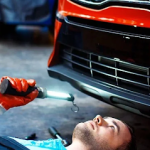The growing popularity of electric vehicles (EVs) has led to an increase in the number of accidents involving these high-tech machines. Knowing how to handle and dispose of electric vehicle components post-accident is an escalating concern. It’s not just about handling an accident scene, but also about ensuring the safe disposal of these specialised components that can pose hazards if improperly discarded. This article will explore in detail the safety protocols for handling and disposing of electric vehicle components post-accident.
Assessing the Scene and Taking Precautions
Before delving into the procedures for handling and disposing of electric vehicle components, it’s essential to understand how to assess an accident scene involving an EV. This section will cover the necessary steps to ensure safety and prevent further damage or injury.
Also to discover : How often should the wheel studs be inspected and replaced in a vehicle used for track racing?
EVs are unlike their conventional counterparts. They are powered by high-voltage batteries, presenting unique hazards. Therefore, first responders arriving at an accident scene involving an EV need to exercise extra caution. They must immediately identify the vehicle as electric and put in place relevant safety measures. High-voltage cables, usually coloured orange, should not be cut or tampered with, as this could lead to a lethal electric shock.
The emergency shut-off system should be activated if possible, to minimize the risk of electrical accidents. Furthermore, responders should use personal protective equipment (PPE), including insulated gloves and safety goggles, while handling EV components.
Also to read : How should you test and maintain active yaw control systems in performance vehicles?
Dealing with Battery Damage
One of the prime concerns when dealing with electric vehicle accidents is battery damage. This section will guide you through the steps to manage situations when an EV’s high-voltage battery is compromised.
In case of severe damage to the battery, the battery’s hazardous materials could leak, posing serious safety risks. Firefighters should be prepared to deal with potential battery fires, which require specific techniques for extinguishment. Using plenty of water is recommended, as trying to extinguish a lithium-ion battery fire with foam or dry powder can be ineffective.
After the immediate risks are contained, the damaged battery should be disconnected and removed from the vehicle. To carry out this operation, one should be trained in high-voltage battery removal and always comply with the manufacturer’s guidelines.
Post-Accident Handling and Storage
Post-accident handling and storage of damaged EV components, particularly the battery, necessitate particular attention. This section aims to provide a clear understanding of how to safely store and transport these elements after an accident.
EV batteries that have been involved in an accident should be stored in a dry and ventilated area, away from flammable materials. They should never be stored in a confined space or near metal objects that could cause a short circuit.
If the battery needs to be transported, it should be packaged appropriately to limit the risk of movement during transit. It is also crucial to inform the transporter that the shipment contains a damaged EV battery, which is classified as a dangerous good.
Disposing of Electric Vehicle Components
Proper disposal of EV components is a crucial aspect of managing the aftermath of an accident. In this section, we discuss the best practices for disposing of damaged EV parts.
Damaged EV components, especially batteries, should never be disposed of in regular waste. They contain hazardous materials that can contaminate the environment if not handled properly.
Instead, these components should be taken to licensed waste management facilities that have the capacity to handle hazardous waste. Some manufacturers also have take-back programs for their products, offering a responsible way to dispose of damaged EV parts.
Training and Education
Given the unique risks associated with electric vehicles, it’s essential for those involved in their post-accident handling to receive adequate training and education. This section emphasizes the importance of training in managing EV accident scenes safely and effectively.
There’s a need for first responders, tow truck drivers, and waste management personnel to receive specialized training in EV safety protocols. This training should cover the recognition of EVs, understanding potential hazards, safe handling of high-voltage components, and safe disposal practices.
Additionally, public awareness campaigns can play a role in educating EV owners about what to do in case of an accident, minimizing risks and ensuring safety.
In summary, managing the aftermath of an EV accident requires careful handling of the vehicle’s components, particularly the high-voltage battery. The safety protocols outlined in this article aim to minimize the risks associated with electric vehicles, protect those involved in their handling and disposal, and preserve the environment by ensuring the proper disposal of hazardous materials.
EV Accident Reporting Procedures
Following an accident involving an electric vehicle, proper reporting procedures are vital for various reasons. This section will discuss the need for specific reporting procedures for EV accidents and what those procedures might involve.
Firstly, accurate reporting of incidents helps insurance companies accurately assess the cost of damage and replacement of EV components. It also provides valuable data to vehicle manufacturers and regulatory bodies, aiding in the development of better safety measures and regulations.
Following an EV accident, along with usual accident reporting, details about the damage to EV components, particularly the battery, should be carefully recorded. Any unusual occurrences, such as battery fires or electric shocks, should be specifically noted.
Moreover, it is highly recommended that a professional EV technician inspects the vehicle post-accident. Their expert assessment will guide the repair, replacement, and disposal procedures of damaged components. This inspection report should form a part of the accident report.
Summary and Key Points
In conclusion, handling and disposing of electric vehicle components post-accident present unique challenges that necessitate specific safety protocols. The unique design and the presence of high-voltage batteries in these vehicles demand extra caution from first responders, mechanics, tow truck drivers, and waste management personnel.
It’s crucial to identify an EV at an accident scene promptly, taking care to avoid contact with high-voltage cables. The damaged battery should be dealt with carefully, using ample water to extinguish battery fires if necessary. Post-accident, the battery should be stored in a dry, ventilated area away from flammable materials and never near metal objects.
When disposing of damaged EV components, they should be taken to licensed waste management facilities capable of handling hazardous waste, or manufacturers who offer take-back programs.
In light of these hazards, adequate training and education for those who might come into contact with damaged EVs are necessary. This includes first responders, tow truck drivers, and waste management personnel, as well as the general public.
The rise of electric vehicles has brought many benefits, but it’s essential that as their numbers on our roads increase, so does our awareness and understanding of the specific safety measures required when things go wrong. Following the outlined safety protocols can help to protect people, property, and the environment in the unfortunate event of an EV accident.












